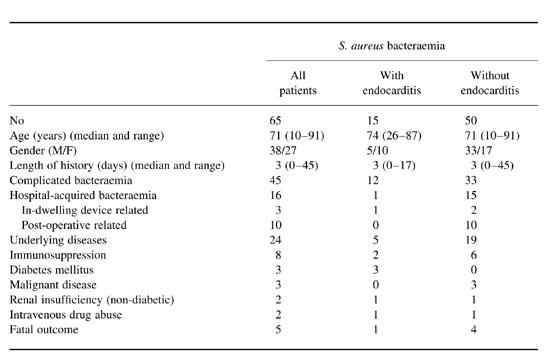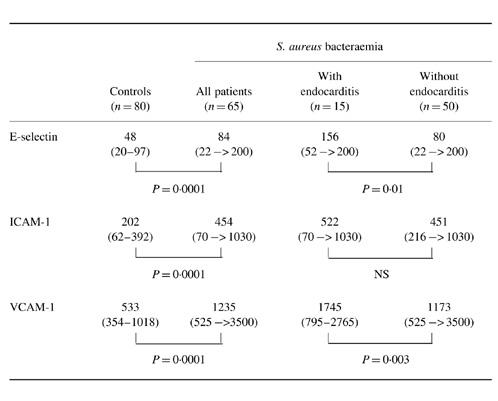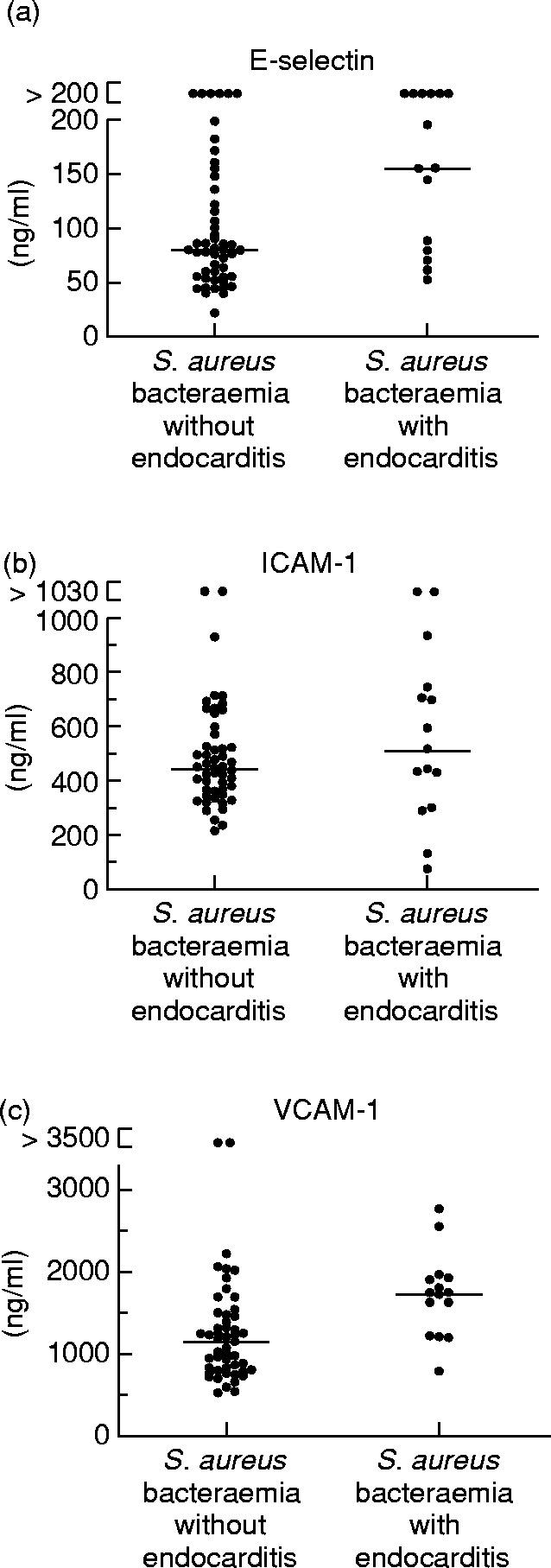Abstract
The aim of this prospective study was to evaluate if patients with endocarditis display a more extensive endothelial activation than those with bacteraemia but without endocarditis. Sixty-five patients with blood culture-verified Staphylococcus aureus bacteraemia were included and serum samples collected on admission were analysed by enzyme immunoassays. Elevated serum concentrations of adhesion molecules were found in most of the patients with S. aureus bacteraemia. Patients with endocarditis (n = 15) showed significantly higher serum E-selectin (median 156 ng/ml) and VCAM-1 (median 1745 ng/ml) concentrations compared with those with S. aureus bacteraemia but without endocarditis (80 ng/ml and 1172 ng/ml, respectively; P = 0.01 and P = 0.003). No significant difference was found between the groups concerning ICAM-1 (median 451 ng/ml versus 522 ng/ml). In addition, serum tumour necrosis factor-alpha (TNF-α) concentrations were significantly correlated (P < 0.002) to serum levels of E-selectin, ICAM-1 and VCAM-1.
Keywords: adhesion molecules, E-selectin, intercellular adhesion molecule-1, vascular cell adhesion molecule-1, Staphylococcus aureus, bacteraemia, septicaemia, endocarditis
INTRODUCTION
Staphylococcus aureus is still one of the most common human pathogens in both community- and hospital-acquired infections. Septicaemia is the most serious condition caused by S. aureus and the organism tends to be a virulent valvular pathogen causing endocarditis [1].
Endothelial cells play a fundamental role in the development of inflammatory processes and various stimuli result in endothelial activation and endothelial–leucocyte interactions including adhesion and extravasation. These interactions are mediated by augmented expression of adhesion molecules, such as E-selectin, ICAM-1, and VCAM-1. Cytokines regulate the local mobilization of leucocytes into inflammatory sites. Thus, IL-1 and IL-4, interferon-gamma (IFN-γ) and tumour necrosis factor-alpha (TNF-α) up-regulate the expression of the endothelial cell ligands VCAM-1, ICAM-1 and E-selectin which promote leucocyte extravasation [2–5]. The adhesion molecules are also released from endothelial cells and can be demonstrated as soluble forms in the circulation [6].
Increased concentrations of circulating soluble adhesion molecules have been reported in patients with systemic inflammatory response syndrome (SIRS), sepsis and septic shock. Also associations have been found between increased concentrations of adhesion molecules and either multiple organ dysfunction, disease severity or death [4,7,8].
The aim of the present study was to evaluate if patients with endocardial involvement (endocarditis) display a more extensive endothelial activation, expressed as increased levels of soluble adhesion molecules, than patients with bacteraemia but without endocarditis.
PATIENTS AND METHODS
Patients
In a prospective study, 65 consecutive patients with verified (Bactec 660 HP) S. aureus bacteraemia admitted to the Department of Infectious Diseases of the Örebro Medical Centre Hospital during 1988–92 were further studied. Patient sera were collected as early as possible on admission. Sera were stored at −70°C pending analysis.
The characteristics of the patients are summarized in Table 1. Fifteen patients (24%) fulfilled the criteria of endocarditis (one definite, six probable and eight possible) according to the strict case definitions proposed by von Reyn et al. [9]. Seven patients fulfilled the Duke criteria of definite infective endocarditis [10]. Complicated bacteraemia, such as acute osteomyelitis, septic arthritis or extensive abscesses, was found in 45 patients.
Table 1.
The characteristics of 65 patients with Staphylococcus aureus bacteraemia with and without endocarditis

Five patients (8%) died in close relation to the acute bacteraemic event (3–15 days after admission to hospital).
The mean length of history (i.e. number of days from onset of symptoms to admission) was 5.2 days (median 3 days, range 0–45 days) and 18 patients had a length of history of more than 1 week.
Controls
Serum samples from 80 healthy individuals (median age 54 years and range 25–86 years) were used as normal controls.
Adhesion molecule assays
The serum concentrations of adhesion molecules were analysed by commercial EIAs for soluble E-selectin, ICAM-1 and VCAM-1 ParameterTM Adhesion Molecule (R&D Systems, Minneapolis, MN). The assays were performed according to the manufacturer's instructions. The processing time for the tests was 6 h. The detection limits of assays for E-selectin and ICAM-1 were 2 ng/ml and 7 ng/ml, respectively, when the samples were diluted 1:20 and for VCAM-1 100 ng/ml when samples were diluted 1:50.
TNF-α, IL-1β, IL-6, IL-8 and granulocyte colony-stimulating factor assays
The cytokine analyses were performed by commercial EIAs for TNF-α, IL-1β, IL-6, and IL-8 enzyme amplified sensitivity immunoassays (EASIAs; Medgenix Diagnostics, Fleurus, Belgium) and by QuantikineTM Human granulocyte colony-stimulating factor (G-CSF) Immunoassay (R&D Systems). The assays were performed according to the manufacturers' instructions.
Statistical analysis
The Mann–Whitney U-test was used for comparing various parameters in different groups, and Spearman's rank correlation test was applied for evaluating correlations between parameters. P < 0.05 was considered significant.
The statistical package StatView 4.01 was used for the calculations.
RESULTS
The serum levels of the adhesion molecules E-selectin, ICAM-1 and VCAM-1 in 65 patients with S. aureus bacteraemia are shown in Table 2 and Fig. 1. The serum concentrations of adhesion molecules were significantly higher in patients with S. aureus bacteraemia compared with controls (P = 0.0001). Among the 80 healthy controls no significant correlation was found between age and the serum levels of E-selectin, ICAM-1 or VCAM-1, although slightly higher levels were present in the elderly. No difference of the control subjects according to gender was found.
Table 2.
Serum concentrations (median and range) of soluble E-selectin, ICAM-1 and VCAM-1 on admission in 65 patients with Staphylococcus aureus bacteraemia with and without endocarditis and in 80 controls

Fig. 1.

Serum concentrations of soluble E-selectin, ICAM-1 and VCAM-1 (bars indicate median value) on admission in patients with Staphylococcus aureus bacteraemia with and without endocarditis.
Patients with S. aureus bacteraemia and endocarditis showed significantly higher serum E-selectin (P = 0.01) and VCAM-1 (P = 0.003) concentrations compared with those with S. aureus bacteraemia without endocarditis. These differences were also present for patients with definite and probable endocarditis compared with those with bacteraemia but without definite and probable endocarditis. No significant difference was found between the groups concerning ICAM-1.
No differences were found in serum adhesion molecule levels between survivors and non-survivors.
No differences were found in serum adhesion molecule levels between patients with a complicated bacteraemia and patients with an uncomplicated bacteraemia.
The serum concentrations of the cytokines IL-6, TNF-α, IL-1β, G-CSF and IL-8 in these patients with S. aureus bacteraemia have previously been reported [11,12]. Serum TNF-α concentrations were highly correlated (P < 0.002) to serum levels of E-selectin, ICAM-1 and VCAM-1. No overall correlation between serum levels of IL-6, IL-8 and G-CSF and the adhesion molecules was found, though some individual correlations were noted. G-CSF correlated to E-selectin (P = 0.003), IL-8 to VCAM-1 (P = 0.008) and IL-6 to both ICAM-1 (P = 0.02) and VCAM-1 (P = 0.001).
No correlation was found between the length of history and the levels of adhesion molecules.
DISCUSSION
Endothelial activation contributes significantly to the systemic inflammatory response to bacteraemia. Increased expression and release of soluble endothelial markers into the circulation have been demonstrated. Elevated plasma levels of E-selectin have been reported in bacteraemic patients, especially in those with sustained systemic hypotension [4]. It has also been proposed that the release of E-selectin is related to the degree of vascular or endothelial injury caused by the sepsis [4]. Increased plasma and serum levels of VCAM-1 and ICAM-1 have been shown in bacteremic patients [7,8]. E-selectin as well as ICAM-1 has also been found to be associated with multiple organ dysfunction, septic shock and death [7,8].
In our study, we found that most of the patients with S. aureus bacteraemia, without signs of shock, had elevated levels of adhesion molecules.
The length of history of illness did not seem to have any influence on the levels of adhesion molecules on admission. As long as the microorganism is present, the endothelial cells will continuously be exposed to bacterial products and stimulated by cytokines. During endocarditis the formation of circulating immune complexes, which are identified to contain bacterial components, may also contribute, directly or indirectly, to the stimulation of endothelial cells. Expression of adhesion molecules in vivo can be maintained for several days after stimulation [13]. We have previously shown that the serum IL-6 concentrations of these S. aureus bacteraemic patients are elevated on admission independently of the length of history, and not until treatment is instituted do the levels decrease [14]. This might also explain the finding that no differences in serum levels of adhesion molecules were found between patients with complicated bacteraemia and those with uncomplicated bacteraemia. However, after the institution of antibiotic treatment the kinetics of the levels of various adhesion molecules might differ between the two groups, since those with complicating bacteraemia may possess a long-standing inaccessible focus. The result of such a condition might be a long-lasting elevation of cytokine concentrations in serum [11].
The highest serum concentrations of both various cytokines as well as adhesion molecules have been reported in patients with septic shock and fatal outcome [4,7,8]. In the present study non-survivors showed higher serum levels of all the three adhesion molecules compared with those who did survive, but the differences did not reach statistical significance. This might be explained by the low mortality rate found in the present study.
Patients with S. aureus bacteraemia and endocarditis, which represents a sustained endothelial involvement, showed significantly higher E-selectin and VCAM-1 concentrations on admission than those with S. aureus bacteraemia but without endocarditis. No difference was found concerning ICAM-1. Endothelial cells express and release adhesion molecules upon activation [3,5]. The principal source of E-selectin and VCAM-1 is the endothelial cell [2,4,15], whilst ICAM-1 is expressed by endothelial cells as well as by fibroblasts, leucocytes and epithelial cells [2,15]. This circumstance may explain the lack of significant difference concerning ICAM-1, since not only the activated endothelium but also various other cell types express ICAM-1.
The production and release of adhesion molecules by endothelial cells are stimulated by various cytokines (TNF-α, IL-1, IL-4, IFN-γ), endotoxin, and live bacteria [3–5]. We found an overall correlation between serum concentrations of TNF-α and E-selectin, ICAM-1 and VCAM-1 on admission. In addition, some individual correlations between the adhesion molecules and IL-6, IL-8 or G-CSF were found. IL-1β was not possible to analyse, since only a few patients showed elevated IL-1β concentrations on admission.
Determining adhesion molecules in serum samples in the acute phase of a septic event might add important diagnostic information, especially when endocarditis is suspected. Strongly elevated serum levels of E-selectin, ICAM-1 and/or VCAM-1 indicate an extensive activation of the endothelium and maybe even the presence of endocarditis, which might be the result of exposure to components such as bacterial antigens, cytokines and circulating immune complexes. However, the potential clinical value of establishing the diagnosis of endocarditis by measuring serum adhesion molecule concentrations is diminished by the presence of an overlap between the groups of bacteraemic patients with and without endocarditis.
In conclusion, increased serum concentrations of adhesion molecules were found in patients with S. aureus bacteraemia. Significantly higher serum levels of E-selectin and VCAM-1 were demonstrated in patients with endocarditis compared with those without endocarditis which might reflect a more extensive activation of endothelial cells. It remains to be determined whether elevated adhesion molecule levels result from focal release of adhesion molecules at the site of endocardial involvement, or from the systemic effects of severe bacteraemic disease.
Acknowledgments
We thank Margareta Jurstrand for excellent laboratory assistance. This study was supported by grants from the Research Foundations of the Department of Infectious Diseases, Örebro Medical Centre Hospital and Örebro County Council.
REFERENCES
- 1.Bayer AS. Infective endocarditis. Clin Infect Dis. 1993;17:313–22. doi: 10.1093/clinids/17.3.313. [DOI] [PubMed] [Google Scholar]
- 2.Gearing AJH, Hemingway I, Pigott R, et al. Soluble forms of vascular adhesion molecules, E-selectin, ICAM-1, and VCAM-1: pathologic significance. Ann NY Acad Sci. 1992;667:324–31. doi: 10.1111/j.1749-6632.1992.tb51633.x. [DOI] [PubMed] [Google Scholar]
- 3.Leewenberg JFM, Smeets EF, Neefjes JJ, et al. E-selectin and intercellular adhesion molecule-1 are released by activated human endothelial cells in vitro. Immunol. 1992;77:543–9. [PMC free article] [PubMed] [Google Scholar]
- 4.Newman W, Beall LD, Carson CW, et al. Soluble E-selectin is found in supernatants of activated endothelial cells and is elevated in the serum of patients with septic shock. J Immunol. 1993;150:644–54. [PubMed] [Google Scholar]
- 5.Pigott R, Dillon LP, Hemingway IH, Gearing AJH. Soluble forms of E-selectin, ICAM-1 and VCAM-1 are present in the supernatants of cytokine-activated endothelial cells. Biochem Biophys Res Commun. 1992;187:584–9. doi: 10.1016/0006-291x(92)91234-h. [DOI] [PubMed] [Google Scholar]
- 6.Gearing AJ, Newman W. Circulating adhesion molecules in disease. Immunol Today. 1993;14:506–12. doi: 10.1016/0167-5699(93)90267-O. [DOI] [PubMed] [Google Scholar]
- 7.Cowley HC, Heney D, Gearing AJH, Hemingway I, Webster NR. Increased circulating adhesion molecule concentrations in patients with systemic inflammatory response syndrome: a prospective cohort study. Crit Care Med. 1994;22:651–7. doi: 10.1097/00003246-199404000-00022. [DOI] [PubMed] [Google Scholar]
- 8.Sessler CN, Windsor AC, Schwartz M, et al. Circulating ICAM-1 is increased in septic shock. Am J Respir Crit Care Med. 1995;151:1420–7. doi: 10.1164/ajrccm.151.5.7735595. [DOI] [PubMed] [Google Scholar]
- 9.von Reyn CF, Levy BS, Arbeit RD, Friedland G, Crumpacker CS. Infective endocarditis: an analysis based on strict case definitions. Ann Intern Med. 1981;94:505–18. doi: 10.7326/0003-4819-94-4-505. [DOI] [PubMed] [Google Scholar]
- 10.Durrack DT, Lukes AS, Bright DK. New criteria for diagnosis of infective endocarditis: utilisation of specific echocardiographic findings. Am J Med. 1994;96:200–22. doi: 10.1016/0002-9343(94)90143-0. [DOI] [PubMed] [Google Scholar]
- 11.Söderquist B, Sundqvist KG, Vikerfors T. Kinetics of interleukin-6, tumor necrosis factor-α and interleukin-1β in patients with Staphylococcus aureus septicemia. Immunol Infect Dis. 1994;4:235–42. [Google Scholar]
- 12.Söderquist B, Danielsson D, Holmberg H, Vikerfors T. Granulocyte colony-stimulating factor (G-CSF) and interleukin-8 (IL-8) in sera from patients with Staphylococcus aureus septicemia. Clin Microbiol Infect. 1995;1:101–9. doi: 10.1111/j.1469-0691.1995.tb00452.x. [DOI] [PubMed] [Google Scholar]
- 13.Norris P, Poston RN, Thomas DS, et al. The expression of endothelial leukocyte adhesion molecule-1 (ELAM-1), intercellular adhesion molecule-1 (ICAM-1) and vascular cell adhesion molecule-1 (VCAM-1) in experimental cutaneous inflammation: a comparison of ultraviolet B erythema and delayed hypersensitivity. J Invest Dermatol. 1991;96:763–70. doi: 10.1111/1523-1747.ep12471720. [DOI] [PubMed] [Google Scholar]
- 14.Söderquist B, Sundqvist KG, Jones I, Holmberg H, Vikerfors T. Interleukin-6, C-reactive protein, lactoferrin and white blood cell count in patients with Staphylococcus aureus septicemia. Scand J Infect Dis. 1995;27:375–80. doi: 10.3109/00365549509032734. [DOI] [PubMed] [Google Scholar]
- 15.Carlos TM, Harlan JM. Leukocyte-endothelial adhesion molecules. Blood. 1994;84:2068–101. [PubMed] [Google Scholar]


